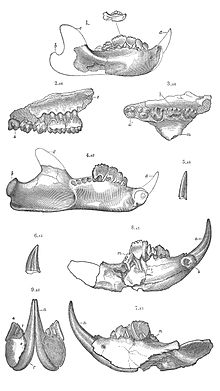 Global Information
Global InformationPlagiaulacoid information
A plagiaulacoid is a type of blade-like, most often serrated, tooth present in various mammal groups, usually a premolar. Among modern species it is present chiefly on diprotodontian marsupials (specifically, Potoroidae, Bettongia and Burramys), which have both the upper and lower first premolars converted into serrated blades. However, various other extinct groups also possessed plagiaulacoids. These would be multituberculates, some "Plesiadapiformes" such as Carpolestes and various metatherians such as Epidolops and various early diprotodontians. In many of these only a lower premolar became converted into a blade, while the upper premolars showed less specialisation.[1][2]
The various independent development of these teeth is considered a good example of convergent evolution.[3][4][5]
Multituberculates in particular probably own the most specialised of all plagiaulacoids. In early taxa, all lower premolars became plagiaulacoids, forming a "saw"-like arrangement. However, in Cimolodonta, premolars 1-3 degenerated and became peg-like or disappeared altogether; instead, only the fourth lower premolar remained, which increased in size. While earlier multituberculates displayed a normal tooth replacement for their plagiaulacoids, in cimolodonts this tooth was not replaced, being the last tooth to erupt and remaining through the animal's life.[6]



- ^ George Gaylord Simpson, The "Plagiaulacoid" Type of Mammalian Dentition A Study of Convergence George Gaylord Simpson Journal of Mammalogy Vol. 14, No. 2 (May, 1933), pp. 97-107 Published by: American Society of Mammalogists DOI: 10.2307/1374012 Stable URL: https://www.jstor.org/stable/1374012
- ^ Susan Cachel, Fossil Primates, Cambridge University Press, 23/04/2015
- ^ George Gaylord Simpson, The "Plagiaulacoid" Type of Mammalian Dentition A Study of Convergence George Gaylord Simpson Journal of Mammalogy Vol. 14, No. 2 (May, 1933), pp. 97-107 Published by: American Society of Mammalogists DOI: 10.2307/1374012 Stable URL: https://www.jstor.org/stable/1374012
- ^ Susan Cachel, Fossil Primates, Cambridge University Press, 23/04/2015
- ^ Kielan-Jaworowska, Zofia, Richard L. Cifelli, and Zhe-Xi Luo (2005). Mammals from the Age of Dinosaurs: Origins, Evolution, and Structure
- ^ Kielan-Jaworowska, Zofia, Richard L. Cifelli, and Zhe-Xi Luo (2005). Mammals from the Age of Dinosaurs: Origins, Evolution, and Structure